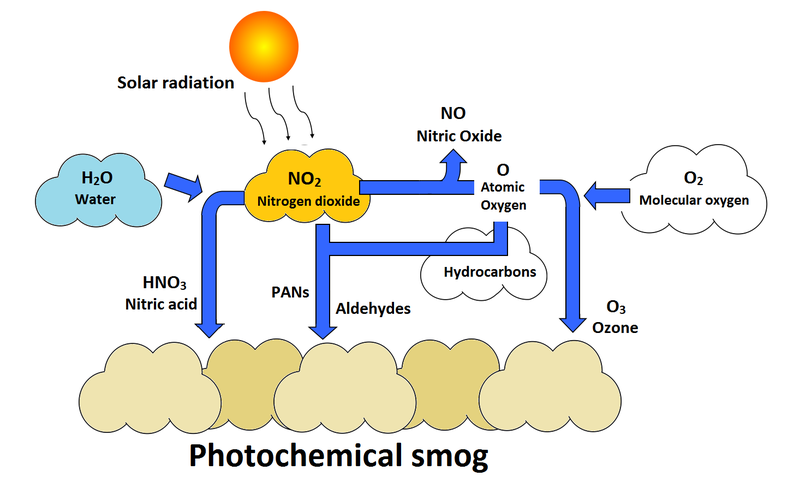Q. Explain the formation of Photochemical smog and its effects.
Photochemical smog is a type of smog produced when ultraviolet light from the sun reacts with nitrogen oxides in the atmosphere. It is visible as a brown haze, and is most prominent during the morning and afternoon, especially in densely populated, warm cities.
Photochemical smog forms from a complex process, however the source of it is quite apparent. The largest contributor is automobiles, while coal-fired power plants and some other power plants also produce the necessary pollutants to facilitate its production. Due to its abundance in areas of warmer temperatures, photochemical smog is most common in the summer.
It forms in the morning when a tremendous number people are driving their vehicles to work. Nitrogen oxides produced in the car engine are introduced into the atmosphere, which may combine with water to form nitric acid or react with sunlight to produce singular oxygen atoms, which then combine with molecular oxygen to produce ozone. The nitric acid may precipitate to the Earth resulting in acid rain, or remain in the smog. Due to the direct production of it by vehicles, the smog forms over cities where many people may encounter its adverse health effects.
Composition
Nitric oxide (NO) and nitrogen dioxide (NO2) are emitted from the combustion of fossil fuels, along with being naturally emitted from things such as volcanos and forest fires. When exposed to ultraviolet radiation, NO2 goes through a complex series of reactions with hydrocarbons to produce the components of photochemical smog—a mixture of ozone, nitric acid, aldehydes, peroxyacyl nitrates (PANs) and other secondary pollutants.


Effects of Photochemical Smog
- NO2, ozone and PANs are called photochemical oxidants because they can react and oxidize certain compounds in the atmosphere or within a person's lungs that are not normally oxidized. Even small traces of these chemicals can affect the respiratory tract of humans and animals, and damage crops and trees.
- Photochemical smog has many adverse effects. When combined with hydrocarbons, the chemicals contained within it form molecules that cause eye irritation. Radicals in the air interfere with the nitrogen cycle by preventing the destruction of ground level ozone. Other effects include reduced visibility and respiratory ailments.
- Ground level ozone is also produced which has various effects on the human body.
REFERENCE :
2. Discuss the Methods to control noise
Some of the ways to control noise pollution are as follows:
(1) Control at Receiver’s End
(2) Suppression of Noise at Source
(3) Acoustic Zoning
(4) Sound Insulation at Construction Stages
(5) Planting of Trees
(6) Legislative Measures.
Noise pollution can be effectively controlled by taking the following measures:
(1) Control at Receiver’s End:
For people working in noisy installations, ear-protection aids like ear-plugs, ear-muffs, noise helmets, headphones etc. must be provided to reduce occupational exposure
(2) Suppression of Noise at Source:
This is possible if working methods are improved by:
(a) Designing, fabricating and using quieter machines to replace the noisy ones.
(b) Proper lubrication and better maintenance of machines.
(c) Installing noisy machines in sound proof chambers.
(d) Covering noise-producing machine parts with sound-absorbing materials to check noise production.
(e) Reducing the noise produced from a vibrating machine by vibration damping i.e. making a layer of damping material (rubber, neoprene, cork or plastic) beneath the machine.
(f) Using silencers to control noise from automobiles, ducts, exhausts etc. and convey systems with ends opening into the atmosphere.
(g) Using glass wool or mineral wool covered with a sheet of perforated metal for the purpose of mechanical protection.
(3) Acoustic Zoning:
Increased distance between source and receiver by zoning of noisy industrial areas, bus terminals and railway stations, aerodromes etc. away from the residential areas would go a long way in minimising noise pollution. There should be silence zones near the residential areas, educational institutions and above all, near hospitals.
(4) Sound Insulation at Construction Stages:
(a) Sound travels through the cracks that get left between the door and the wall. For reducing noise, this space (jamb frame gap) should be packed with sound absorbing material.
(b) Sound insulation can be done by constructing windows with double or triple panes of glass and filling the gaps with sound absorbing materials.
(c) Acoustical tiles, hair felt, perforated plywood etc. can be fixed on walls, ceilings, floors etc. to reduce noise (especially for sound proof recording rooms etc.)
(5) Planting of Trees:
Planting green trees and shrubs along roads, hospitals, educational institutions etc. help in noise reduction to a considerable extent.
(6) Legislative Measures:
Strict legislative measures need to be enforced to curb the menace of noise pollution. Some of these measures could be:
(a) Minimum use of loudspeakers and amplifiers especially near silence zones.
(b) Banning pressure horns in automobiles.
(c) Implementing Noise Pollution Act.











0 comments: